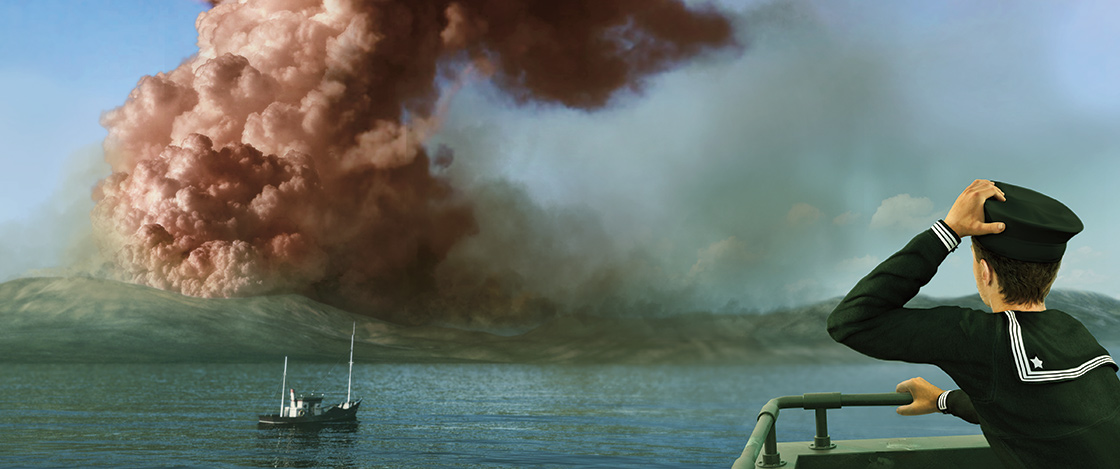Work with struggling readers on a sequencing activity. Have them list the events leading to the explosion in order, and then list what happened after the disaster. They should use their lists to retell what happened, either out loud with a partner or in a short written summary.

The Great Halifax Explosion
The gripping true story of a 1917 accident that caused a blast more powerful than most bombs

Learning Objective: Students will identify key details to help them unpack a challenging narrative nonfiction article about a historical event.
Standards
More About the Story
Skills
main idea and supporting details, key details, vocabulary, text features, author’s craft, interpreting text, sequencing, cause and effect, critical thinking, analyzing, explanatory writing
Complexity Factors
Purpose
“The Great Halifax Explosion" provides information about a terrible disaster that occurred in Halifax Harbor during World War I. The narrative nonfiction telling lets readers understand it through the experiences of a 13-year-old survivor.
Structure
The text is mainly chronological but starts with a flash-forward and concludes in present day, 100 years after the main events. It includes informational passages and cause-and-effect structures.
Language
The article includes some challenging academic vocabulary (e.g. flammable, hulking, vaporized). It features descriptive language and two similes.
Knowledge Demands
Some knowledge of maritime activity may be helpful, but is not required. Map-reading skills or knowledge of geography will also be helpful. The backdrop of the text is World War I.
1. Preparing to Read
Watch a Video; Preview Text Features and Vocabulary (40 minutes)
- Ask students to open to pages 4-5 and read the headline and subhead. Ask: Where is Halifax? Point it out on the map on page 6 or another map. Call on a student to read aloud the Up Close box.
- Show the video “Behind the Scenes: The Great Halifax Explosion.” In it, author Kristin Lewis introduces the topic and her research in Nova Scotia. Have students complete the video activity.
- Show the vocabulary slideshow to introduce challenging vocabulary from the article. Follow up with the vocabulary activity. Highlighted words: harbor, vessels, flammable, hulking, ignited, vaporized, careened, shards, tsunami, tarnished
2. Close Reading
Read and Unpack the Text (45 minutes, activity sheet online)
Read the article as a class, or play our audio version as students follow along. Have students read it a second time in small groups, answering the close-reading and critical-thinking questions.
Close-Reading Questions
- In the first section, what are some examples of what people in Halifax were doing before the explosion? Why does the author include these details? (author’s craft)
Children were getting ready for school, men were heading to work, and people in factories and in the harbor were working. The author probably includes these details to help readers picture the setting and to show that it was an ordinary day before the explosion. - The author says that World War I had “cast a shadow” over Noble’s town. What does she mean? Why was Halifax important in the war? (interpreting text)
The author means that people saw and felt the sad effects of war, like soldiers with serious injuries. Halifax was important because ships from its harbor carried soldiers and supplies to the battles in Europe.
- In the section “A Dark Shadow,” what series of events caused a fire to start on the Mont-Blanc? (sequencing)
The Mont-Blanc was going north while the Imo was heading south. To avoid another ship, the Imo veered into the path of the Mont-Blanc, and the two ships collided. Barrels of benzol aboard the Mont-Blanc spilled, then sparks from the ships rubbing together caused the benzol to ignite.
- What did Mackey know about the Mont-Blanc that most onlookers, like Noble, didn’t know? How might they have acted differently if they had known this secret? (key details)
Mackey knew that the ship was carrying dangerous explosives below deck, which would explode in the fire. If others had known, they likely would have hurried away from the ship rather than toward it to watch.
- Which details in the article help you understand how powerful the explosion was? (key details)
Details include that the center of the explosion probably reached 9,000 degrees; a blast of energy shot out at 5,000 feet per second; ships overturned and trains derailed; factories collapsed; and the ground shook 250 miles away. Also, about 2,000 people died and 9,000 were injured.
- What does the section header “More Horror” refer to? (text features)
It refers to the tsunami that formed as a result of the blast.
- What effects did the explosion have on Noble’s family? On Halifax? (cause and effect)
Noble’s brother Gordon disappeared in the explosion and was never found; their house was destroyed. In Halifax, many people were killed or injured, and much of the town was ruined. But people tried to help each other.
Critical-Thinking Questions
- What do you think you get out of learning about the Halifax explosion? (critical thinking)
Answers will vary. Students might say it shows how unexpectedly a terrible disaster can happen, or that people come together and help each other recover from even the worst disasters. They might also say that learning about the explosion is a way to remember the many people who died or suffered injuries and losses from it. Furthermore, readers learn many factual details about Halifax and World War I. - In what ways did Noble and his family survive the disaster? (analyzing)
Noble remained alive even though he was thrown into the air by the explosion. His family “pushed on” even after losing Noble’s little brother Gordon, and they rebuilt their lives.
3. Skill Building
Featured Skill: Key Details
- Have students complete the main idea and supporting details activity, which will help them identify key details. Then have them respond to the writing prompt on page 9, using the Q&A interview template as a guide.
Act Out Interviews
- After students complete the writing prompt on page 9, have them work in pairs to act out their interviews, imagining they are TV reporters rather than newspaper reporters.
Explore an Interactive Timeline
- Go to arcgis.com. Search for and select “Pilot Francis Mackey & The Halifax Explosion,” then click “View Application.” With students, use the interactive timeline to explore events described in the article. Although the narration may be advanced for some students, the visuals will help them understand what happened.
Students can learn more about the Halifax explosion by reading Blizzard of Glass by Sally Walker. As they complete each chapter, have them gather in book groups to ask each other questions and discuss what they found interesting.
This story contains many colorful verbs that might be unfamiliar to ELLs, including clattered, veered, blared, reversed, collapsed, and surged. Go over their meanings, and encourage students to act each one out.
Encourage students (especially those who enjoy learning about history) to read this article on their own during free-reading time or at home. Then ask them to write a review of it, summarizing what it’s about and telling why someone else might like it.
